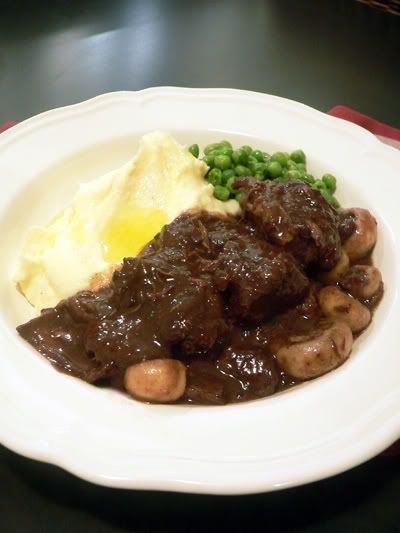
Cooking French food is always lots of fun, especially when you're cooking for a real French person. This Friday, I hosted a little dinner for a few friends, one of which who's French through and through (I also suppose she'd kill me if I did injustice to her national cuisine!). Rather than going all out to do something new, I trusted my better judgement and went with an old favourite of mine that I keep handy in my arsenal for ocassions like this: la boeuf bourguignon!
I've cooked this dish many times before, both at home and at work, and it's one of those dishes that guarantee a high probability of success. I mean seriously, who doesn't have a soft spot in their heart for rich, meaty, fork-tender, slow braised beef?
For the best possible beef bourguignon that you can make, here are some tricks of the trade that I'd be happy to divulge:
1) This dish has its origins in Burgundy, France. Most of the red wine produced in Burgundy is of the Pinot Noir variety, so a deep, full-bodied Pinot Noir would be ideal for use in this dish. If you can't get hold of a rich Pinot Noir (which is highly unlikely considering the wine glut in Australia), you could possibly get by with a Merlot.
2) Choose the beef carefully. I, personally, am not a fan of the usual chuck steak or topside for stews and braises. I feel that they tend to be a tad dry and fibourous even after being cooked to a tender state. When eating a slow-cooked red meat dish, I often look for gelatinous and soft membrane-y bits that add variety to the mouthfeel of the dish. It is for this reason that I love to use the more modest cuts such as cheeks, ribs, shins, briskets and tails, which contain heaps of tough stuff that can be cooked down to gooey-goodness. On this ocassion, I used a mixture of the the first three. (You'd be surprised to learn that the lesser known beef cheeks can actually be found in many larger Woolworths supermarkets, next to where they display the offal. Beef shin is also known as gravy beef, and is commonly found in most supermarkets.)
3) "Depouiller, depouiller, depouiller." That's what a French chef once taught me as the secret to making a great beef bourguignon. Literally translated, it means: "skim, skim, skim", and it refers to the time consuming task of continuously removing the fat and impurities that rise to the top of the sauce as the meat cooks. Lesson 101 on fat and impurities: if you don't skim them off quick enough, they fall back into the sauce to make it cloudy and grainy, a.k.a. - RUINED. A good beef bourguignon should have a sauce that's deep and rich, but still clear and glossy. If necessary, the meat should be removed and the sauce strained several times before serving. As you can see, the French people take a lot of pride in making their dishes perfect, so I think we should too.
You can find a good recipe for beef bourguignon at wikipedia. But if you just apply these three pointers that I have just made in addition to that, I assure you that everyone will be blown away. Yes, even a real French person.

7 comments:
Hi,
You have great blog. Would you mind to have a link exchange with me?
Please email me if you are interested.
my email : kamarul[at]hoteltravel[dot]com
I'd like to exchange your link with our company website.
Thanks.
Note: You can delete this comment.
Looks like you're getting comment-spammed!
I love the beef photo: very glossy. Well done. It looks DELICIOUS! If only it wasn't getting into summer, we could spend another 6 months practicing hearty French winter fare!
Hi,
Is it possible to use shank or ox tail in this recipe?
Hey yumhwa!
Shanks and tails work great.. their high levels of intra-muscular connective tissue mean that there'd be loads of lovely gooey-ness coming from these cuts after they have been cooked for long periods. I'm a personal fan of tails...
Totally agree with the cuts of beef you suggest. I came up with some other pointers http://www.thecotswoldfoodyear.com/2007/11/beef-and-cotswold-way-ale-pie.html
I forgot to mention the skimming and straining. You can use the muslin bag you use for straining fruit jelly/ jam for that.
I couldn't agree more about beef cheeks, they are the ultimate in gooey delight! Keep it under your hat though, otherwise they'll go the way of osso bucco and lamb shanks (as in insanely expensive!)
Try marinating the beef cheeks in a little sugar, fish sauce and garlic, then slow cook with lots of grated ginger and a beer. It's Vietnamese style and very delicious.
I love the Brisbane area (we go to Noosa to visit my father-in-law) and am always happy to hear what's happening in your neck of the woods. (I'm in the States with my Australian husband).
You've made me hungry for beef bourguignon! A great read - I'll be back for more...
Post a Comment